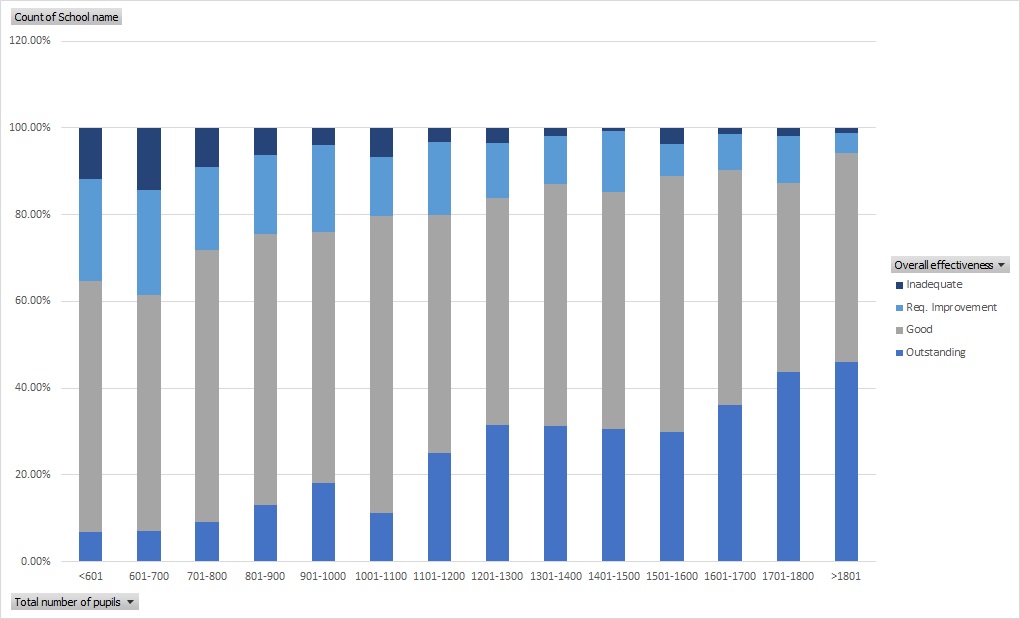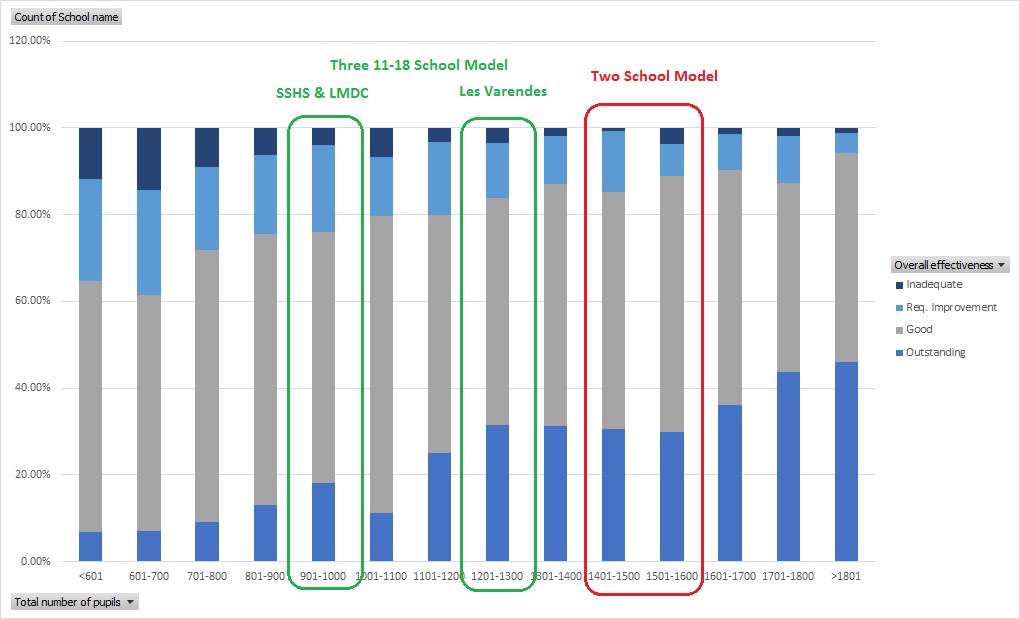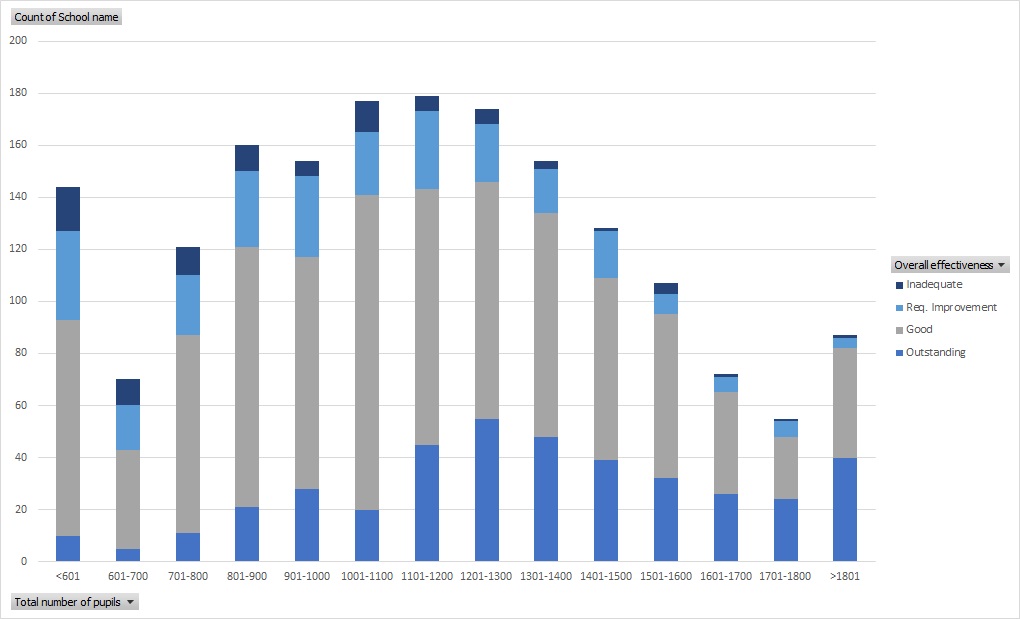Much has been made of the advantages of larger size schools in Guernsey, in that there is greater ability to stream classes by ability, and greater flexibility for curriculum options at both GCSE and A-level. One key plus point provided by CfESC is the statistically higher ranking of larger schools:
“Of the top 200 non-selective comprehensive schools in England (2018 validated data), 159 of these were 11-18 schools with an average student body of 1350 students, very similar to the size of the future colleges.”
Parents in Guernsey aren’t used to looking through schools rankings, as the education system has historically meant that children, on completing their primary schooling, go to the school that they have been assigned to. The mantra “you’ll get what you’re given” rings true for school choice. Parents in the UK however have more options available.
At any one time, there will be thousands of parents all over the UK poring over Ofsted reports and school reviews, trying to determine the best school for their children. It could simply be the closest one, where they will likely stay with their group of friends from primary school. If the local school is good, that’s often the best choice.
Alternatively, it could be one further afield, which would mean more travelling time but might be a better fit for their abilities or aspirations. The change in school system with the removal of selection gives parents in Guernsey a once in a lifetime chance to have some input on the schools their children might go to.
As the size of the schools has emerged as a key consideration, it makes sense to compare options in Guernsey with equivalent schools in the UK. All the Ofsted data listing UK schools and their latest inspection results are available in Excel format for download from this page:
State-funded schools statistics
Schools are graded on a four-point scale, with 1 being the highest:
- grade 1: outstanding
- grade 2: good
- grade 3: requires improvement
- grade 4: inadequate
Looking at the August 2019 dataset and latest inspection result gives an indication how school size affects the grading, bearing in mind that for some schools the latest full inspection may have been some years ago and not match their current state.
This chart shows latest grade by school size, for all non-selective schools with a sixth form but excluding a very small number of new schools that had no grade, or had not yet been inspected:
 This does indeed show a progression by size, but it would be a mistake to assume that simply by creating a new school at 1400 or 1500 capacity, an “outstanding” grade will automatically follow, as there are many factors that can influence a school’s overall grade.
This does indeed show a progression by size, but it would be a mistake to assume that simply by creating a new school at 1400 or 1500 capacity, an “outstanding” grade will automatically follow, as there are many factors that can influence a school’s overall grade.
Creating a large school might be lucky for Guernsey and turn out to be two schools like the much admired Cotswold School with 1376 pupils and ranked outstanding. On the other hand, if things didn’t work out so well, we could end up with a Bexleyheath Academy with 1539 pupils and given the lowest rating of inadequate recently.
There is a lot at stake to be left to chance. In addition, Ofsted have warned that some schools are themselves attempting to “game the system” and achieve higher rankings, using techniques such as “sham qualifications” and “off-rolling” to improve their rankings.
School ranking, particularly the “outstanding” grade, does need to be taken in context and sometimes treated with caution, but can still be a useful guide. Comparing percentages for the sizes of school with a 3x 11-18 model, against two-schools proposed by CfESC, the percentages are indeed better for a two-school model but not dramatically so:
 Whilst the difference in percentage of “outstanding” schools is noticeable in the smaller school size (18% vs. 30%) it is actually improved for the size of school that could exist at Les Varendes (31%) and overall, much less noticeable when looking at counts of “good” + “outstanding” rankings combined.
Whilst the difference in percentage of “outstanding” schools is noticeable in the smaller school size (18% vs. 30%) it is actually improved for the size of school that could exist at Les Varendes (31%) and overall, much less noticeable when looking at counts of “good” + “outstanding” rankings combined.
It is also worth considering that there are numerically many more schools with sixth forms of a similar size to three 11-18 schools in Guernsey, than in the 1400+ category created by a two-school model:
 This shows there are more “good” and “outstanding” schools with a sixth form in either the 801-900 range or the 901-1000 range than in the 1401-1500 range. Clearly, if the conditions are right, it is at least potentially possible to create good schools, with sixth forms, at almost any size from 800 pupils onwards. In some, but not all of the smaller schools with sixth-forms, there are tiny numbers of students in the sixth-form, some as low as 30 places. In many cases, this is achieved with the help of specialisation and partnering with larger nearby schools to provide additional options.
This shows there are more “good” and “outstanding” schools with a sixth form in either the 801-900 range or the 901-1000 range than in the 1401-1500 range. Clearly, if the conditions are right, it is at least potentially possible to create good schools, with sixth forms, at almost any size from 800 pupils onwards. In some, but not all of the smaller schools with sixth-forms, there are tiny numbers of students in the sixth-form, some as low as 30 places. In many cases, this is achieved with the help of specialisation and partnering with larger nearby schools to provide additional options.
This can happen if there is a desire to do so, and the confidence amongst teaching professionals that launching new, additional, sixth-form courses at SSHS and LMDC need not diminish the already excellent sixth-form offering at Les Varendes.
Whilst it is of course understandable to design a school system to “play the percentages” and give the best chance of creating outstanding schools, there are many more factors to consider in a future school system than the size of schools. The 3x 11-18 model, which maintains the existing provision at Les Varendes and launches additional, new sixth-form courses at two other schools, has close match to the school estate in Guernsey, locations close to where people live, parity across the entire system, parental choice, smaller schools in their communities, offers specialism in academic areas, and could aim to live up to a definition of an outstanding school provided by the SSAT with more positivity:
“focusing single-mindedly on performance measures gets you so far. But being outstanding in every sense of the word – for your students, teachers, parents and community – requires a bigger, more courageous vision. It means having your own plan based on what you know is right for your own students. It means subjecting that plan to constant challenge and innovation. Above all, it’s about liberating your teachers to perform brilliantly in the classroom.”
